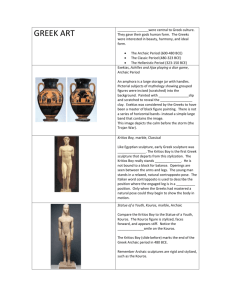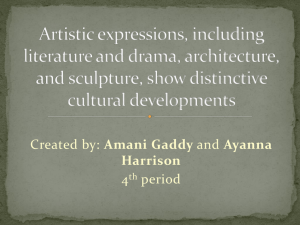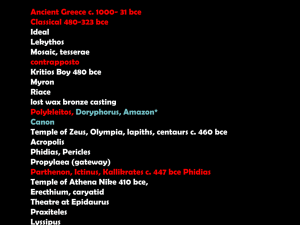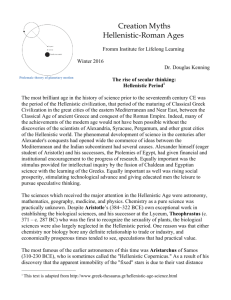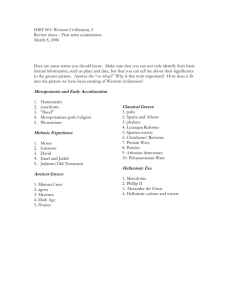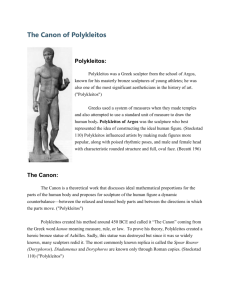Chapter 5 Gods, Heroes, and Athletes
advertisement
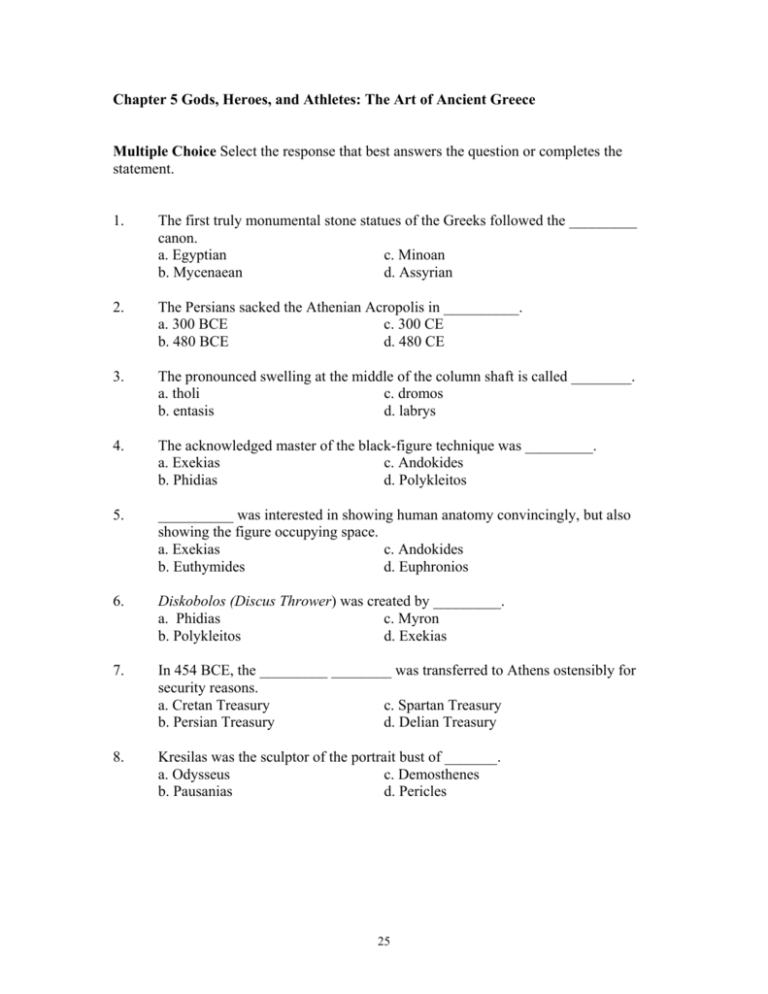
Chapter 5 Gods, Heroes, and Athletes: The Art of Ancient Greece Multiple Choice Select the response that best answers the question or completes the statement. 1. The first truly monumental stone statues of the Greeks followed the _________ canon. a. Egyptian c. Minoan b. Mycenaean d. Assyrian 2. The Persians sacked the Athenian Acropolis in __________. a. 300 BCE c. 300 CE b. 480 BCE d. 480 CE 3. The pronounced swelling at the middle of the column shaft is called ________. a. tholi c. dromos b. entasis d. labrys 4. The acknowledged master of the black-figure technique was _________. a. Exekias c. Andokides b. Phidias d. Polykleitos 5. __________ was interested in showing human anatomy convincingly, but also showing the figure occupying space. a. Exekias c. Andokides b. Euthymides d. Euphronios 6. Diskobolos (Discus Thrower) was created by _________. a. Phidias c. Myron b. Polykleitos d. Exekias 7. In 454 BCE, the _________ ________ was transferred to Athens ostensibly for security reasons. a. Cretan Treasury c. Spartan Treasury b. Persian Treasury d. Delian Treasury 8. Kresilas was the sculptor of the portrait bust of _______. a. Odysseus c. Demosthenes b. Pausanias d. Pericles 25 9. Plutarch claimed that _______ was in charge of the entire Periclean Acropolis project. a. Phidias c. Iktinos b. Kallikrates d. Polykleitos 10. Mnesikles was the architect of note for the _______, the monumental entrance to the Acropolis. a. Parthenon c. Propylaia b. Erechtheion d. Megaron 11. Another Ionic building on the Athenian Acropolis is the ____________, designed by Kallikrates. a. Erechtheion c. Temple of Athena Nike b. Propylaia d. Theater of Dionysos 12. The leading painter of the first half of the fifth century BCE was ____________. a. Polygnotos of Thasos c. Achilles Painter b. Philoxenos of Eretria d. Niobid Painter 13. __________ was one of the leading sculptors of the fourth century BCE. a. Polykleitos c. Phidias b. Iktinos d. Praxiteles 14. ________ was the capital of Macedonia. a. Athens c. Sparta b. Pergamon d. Pella 15. The earliest instance of a/an ____________on the exterior of a Greek building is the Choragic Monument of Lysikrates. a. ionic capital c. doric capital b. corinthian capital d. composite capital 16. The Altar of Zeus, Pergamon, presents in mythological disguise the victory of Attalos I over the _________. a. Romans c. Persians b. Athenians d. Gauls 17. Athanadoros, Hagesandros and Polydoros are thought to be the three Rhodian sculptors who created the _____________. a. Aphrodite from Melos c. Laocoön b. Demosthenes d. Sleeping Satyr 18. Statues of the aged and the ugly can be found in the ________ period. a. Late Classical c. Archaic b. Early Classical d. Hellenistic 26 19. The redefinition of portraiture was one of the great achievements of __________ artists. a. Hellenistic c. Late Classical b. Early Classical d. Archaic 20. ________, Skopas and Lysippos made bold steps in humanizing the gods of Greek statuary in the fourth century BCE. a. Praxiteles c. Polykeitos b. Phidias d. Myron Slide Questions A. Parthenon, Acropolis, Athens (Figure 5-44) 21. 22. 23. 24. B. Aphrodite of Knidos (Figure 5-62) 25. 26. C. Who is depicted in this work? Why is this work significant? How does this image express power? What is the medium? Gaul killing wife and self (Figure 5-80) 31. 32. 33. E. How does this work reflect the period? Who is the sculptor? Athena battling Alkyoneos, detail of the gigantomachy frieze, from the Altar of Zeus (Figure 5-79) 27. 28. 29. 30. D. How does this work conform to the period? How is this work original? Who is/are the architect and/or architects? What is the period? How does this work express Hellenistic art? What message does this work impart on the viewer? Who is thought to be the sculptor? Old Market Woman (Figure 5-86) 34. 35. How does this work reflect the Hellenistic style? Why is this sculpture significant? 27 Short Answers 36. In addition to the caryatids, what is the other Ionic feature on the Siphnian Treasury of Delphi? 37. Define the term “foreshortened.” 38. What is the radical change in the Kritios Boy from earlier Greek statues? 39. Define contrapposto. 40. What is a herm? 41. From a Greek architectural point of view, what makes the Parthenon “perfect?” 42. What are the Elgin marbles? 43. Describe the change in Greek thought and art in the fourth century BCE. 44. What was the difference between the canons of Polykeitos and Lysippos? 28 ANSWERS Multiple Choice 1. A page 106 2. B page 118 3. B page 111 4. A page 114 5. D page 116 6. C page 124 7. D page 125 8. D page 125 9. A page 126 10. C page 131 11. 12. 13. 14. 15. 16. 17. 18. 19. 20. C page 133 A page 135 D page 137 D page 140 B page 144 D page 147 C page 154 D page 152 A page 153 A page 137 Slide Questions A. 21. It has become the culmination of the ideal solution to perfect proportions in Doric temple design. Page 126 22. 23. 24. B. 25. 26. C. 27. The sculptor has made a conscious effort to humanize the goddess. He has depicted her naked and about to enter her bath, a rather mundane activity. She is neither erotic nor licentious; however he has imbued her with a sensuality that is unique and uncommon. Page 137 Praxiteles. Page 137 30. A detail from the Altar of Zeus: Pergamon showing a triumphant Athena battling Alkyoneos. Page 148 It becomes an allusion to the successful campaign of Attalos I in defeating the invasion of the Gauls in Asia Minor. This work takes on the same significance as the earlier rendering on the Parthenon. Page 147 The emotional intensity of the facial expression of the defeated giant, Alkyoneos and the striding figure of the triumphant Athena all indicate power. The gesture of Athena pulling on the hair of Alkyoneos further amplifies the idea of power and augments that idea with the perceptual presentation. Page 148 Marble relief. Page 148 31. The intense emotional quality of the Gaul committing suicide rather than 28. 29. D. Its originality lies in the spacing and slender shafts of the columns. The capitals with their straight-sided conical echinuses become the ultimate refinements for the budging and squat Doric columns and compressed capitals of earlier Doric temples (Temple of Hera (Basilica), Paestum). Page 126 Iktinos and Kallikrates. Page 126 Classical. Page 118 29 32. 33. E. 34. 35. accepting defeat at the hands of the Pergamenes, the gestures and exactitude of presentation all reflect Pergamene Hellenistic art forms. Pages 148-149 The viewer saw and understood the noble and moving response to defeat, but also the extraordinary qualities of the Attalid warriors who defeated the Gauls. Page 149 Epigonos Page 149 It indicates the change in the social climate of the Hellenistic world. No longer were the young and the beautiful dominating the visual vocabulary; now artists were depicting a broader range of physical types. Page 152 The realistic focus is apparent in this work; the great age and obvious poverty of the old woman are stressed. Page 152 Short Answers 36. The other Ionic feature is the continuous sculpture frieze on all four sides of the building. Page 113 37. Drawn in three-quarter view. Page 116 38. The sculptor was not just concerned with representing a body but portraying how a human being (as opposed to a stone statue) actually stands. Page 121 39. Weight shift (counterbalance). Page 121 40. A bust on a square pillar. Page 125 41. The Parthenon may be viewed as the ideal solution to the Greek architect’s quest for perfect proportions in a Doric temple design. Pages 126-127 42. Lord Elgin was the British ambassador to the Ottoman court in the 1800s and was permitted to dismantle many of the sculptures (pediments, friezes and metopes) from the Parthenon. He shipped them to England where he sold them at great personal financial loss to the British government. They are now exhibited in a special gallery in the British Museum, London. Page 126 43. Greek thought and art began to focus more on the individual and the real world of appearances rather than on the community and the ideal world of perfect beings and perfect buildings. Page 137 44. The canon of Lysippos made the bodies more slender and the heads roughly one-eighth the height of the body. Page 139 30

